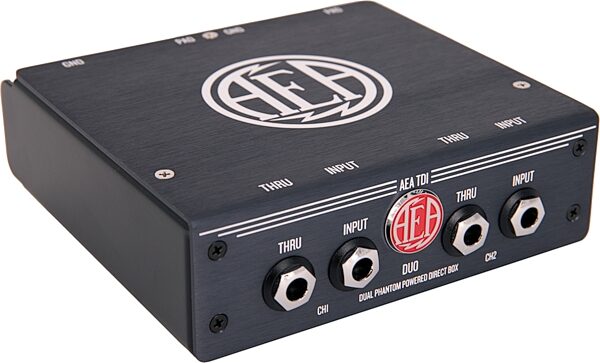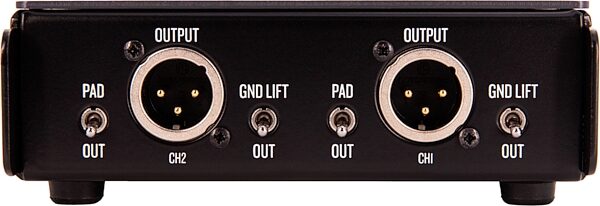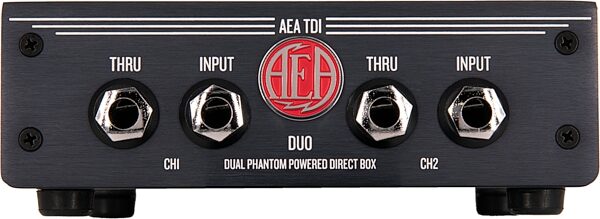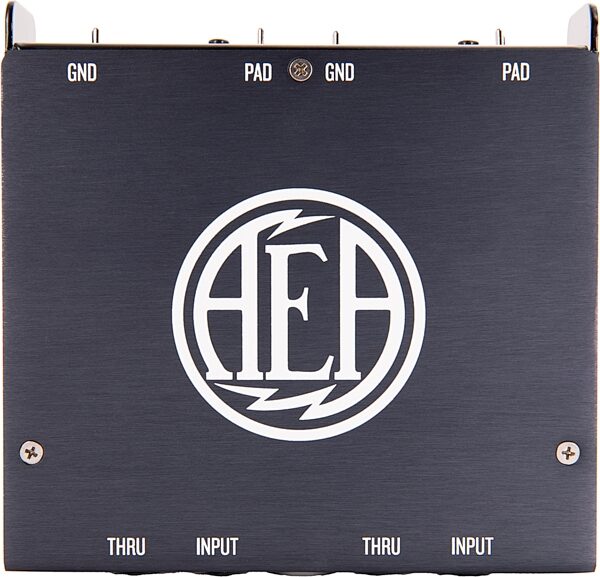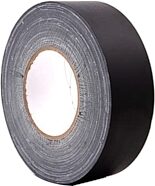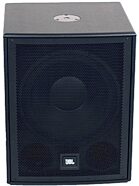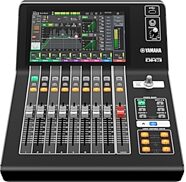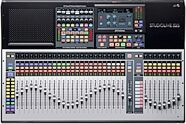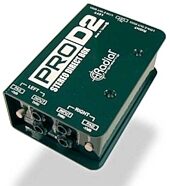AEA Microphones TDI Duo Phantom-Powered Stereo DI Direct Box




Overview
As with all DI boxes, the role of the AEA phantom-powered TDI DUO is to facilitate impedance matching and a drop in level. The TDI works by using an ultra-low-noise JFET to buffer the high impedance of your instrument-level signal. The JFET then drives a super-clean step-down transformer which balances the signal. There is a THRU jack paralleled to the input jack. The TDI allows for outstanding sonic performance while minimizing distortion, noise interference, and signal degradation from long cable runs.
The TDI can handle extremely high input levels without clipping. Its durable steel chassis can withstand the toughest live or studio environments. The Phantom-Powered TDI pairs great with passive instruments like guitars, basses, piezo pickups, etc. Its 20 dB pad can also flawlessly handle speaker-level signals or active instruments such as synths as well. As with all AEA electronics, this circuit was designed by Fred Forssell.
Application
The straight-forward design of the TDI makes set-up and usage simple. Power for the TDI is supplied with standard 48V to the XLR output. Simply plug the 1/4" cable from your instrument into the INPUT jack of the TDI, and connect the OUTPUT via XLR to the next device in your signal chain (preamp, PA, audio interface, etc.), then engage phantom power.
Optionally, you can also use the THRU-put to send your instrument signal to other instrument-level sources (such as amplifiers). The THRU-put feature is also useful for simultaneous wet/dry… read more signal tracking.
- While the steel chassis does shield the transformer from most electro-magnetic interference, it is always a good idea to avoid placing the unit near power amps whenever possible.
- If you experience hum after connection, try engaging the "GROUND LIFT" switch on the back of the TDI. If hum continues, try removing or powering off other devices in the same power circuit.
- For hotter sound sources, you may want to consider using the PAD function for a -20 dB attenuation.
- The JFET drives the super-clean step-down transformer which balances the signal
- Has a THRU jack paralleled to the input jack
- The TDI can handle extremely high input levels without clipping
- 48V Phantom powered
- 20dB pad
- Ground Lift
read less
The TDI can handle extremely high input levels without clipping. Its durable steel chassis can withstand the toughest live or studio environments. The Phantom-Powered TDI pairs great with passive instruments like guitars, basses, piezo pickups, etc. Its 20 dB pad can also flawlessly handle speaker-level signals or active instruments such as synths as well. As with all AEA electronics, this circuit was designed by Fred Forssell.
Application
The straight-forward design of the TDI makes set-up and usage simple. Power for the TDI is supplied with standard 48V to the XLR output. Simply plug the 1/4" cable from your instrument into the INPUT jack of the TDI, and connect the OUTPUT via XLR to the next device in your signal chain (preamp, PA, audio interface, etc.), then engage phantom power.
Optionally, you can also use the THRU-put to send your instrument signal to other instrument-level sources (such as amplifiers). The THRU-put feature is also useful for simultaneous wet/dry… read more signal tracking.
Guidelines
- To avoid loud pops while engaging phantom power to the unit, be sure all volume levels in your signal chain are muted.- While the steel chassis does shield the transformer from most electro-magnetic interference, it is always a good idea to avoid placing the unit near power amps whenever possible.
- If you experience hum after connection, try engaging the "GROUND LIFT" switch on the back of the TDI. If hum continues, try removing or powering off other devices in the same power circuit.
- For hotter sound sources, you may want to consider using the PAD function for a -20 dB attenuation.
Features:
- TDI works by using an ultra-low-noise JFET to buffer the high impedance of your instrument-level signal- The JFET drives the super-clean step-down transformer which balances the signal
- Has a THRU jack paralleled to the input jack
- The TDI can handle extremely high input levels without clipping
- 48V Phantom powered
- 20dB pad
- Ground Lift
Specs
- Noise Floor (22 Hz - 22 kHz, unweighted): Better than -114 dBu
- Frequency Response: -0.5 dB: <10 Hz - 50 kHz, -3 dB: <10 Hz - 120 kHz
- THD+N: (22 Hz - 22 kHz): 1 kHz, 0 dBu input: 0.0020%
- Input Impedance: Instrument: 10 MO, With Pad: 55 kO
- Output Impedance: <50 O balanced output
- Output level (pad out): Input level -20 dB
- Output level (pad in): Input level -40 dB
- Pad: -20 dB
- Power Consumption: Phantom Power, +48VDC, less than 8 mA
- Output XLR Polarity: Pin 2 high
- Dimensions: 5.2" X 5.2" X 1.8"
- Weight: 1lb 13oz (~820 g)
- Frequency Response: -0.5 dB: <10 Hz - 50 kHz, -3 dB: <10 Hz - 120 kHz
- THD+N: (22 Hz - 22 kHz): 1 kHz, 0 dBu input: 0.0020%
- Input Impedance: Instrument: 10 MO, With Pad: 55 kO
- Output Impedance: <50 O balanced output
- Output level (pad out): Input level -20 dB
- Output level (pad in): Input level -40 dB
- Pad: -20 dB
- Power Consumption: Phantom Power, +48VDC, less than 8 mA
- Output XLR Polarity: Pin 2 high
- Dimensions: 5.2" X 5.2" X 1.8"
- Weight: 1lb 13oz (~820 g)
- Dimensions and Weight in Packaging
- Base Item
- Shipping Weight: 1.97 lbs
- Shipping Dimensions: 6 x 6 x 2 in
- Manufacturer Part Number (MPN): TDI Duo
Documents and Manuals
For support or warranty questions, please contact the manufacturer:
Web: https://aearibbonmics.com/support/
Web: https://aearibbonmics.com/support/
New
$499.00
- 8 x$62.38
FREE -Day Shipping!
Get it
for
Get it
(or get it
with an order of
),
if you order within
Shipping to
This is a carousel with product cards. Use the previous and next buttons to navigate.
People who bought this item also bought
This is a carousel with product cards. Use the previous and next buttons to navigate.
